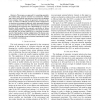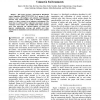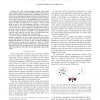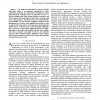IROS
2009
IEEE
14 years 6 months ago
2009
IEEE
—Robust localization of robots and reliable tracking of people are both critical requirements for the deployment of service robots in real-world environments. In crowded public s...
IROS
2009
IEEE
14 years 6 months ago
2009
IEEE
— We propose an approach for acquiring geometric 3D models using cameras mounted on autonomous vehicles and robots. Our method uses structure from motion techniques from computer...
IROS
2009
IEEE
14 years 6 months ago
2009
IEEE
— This paper presents a bio-inspired, distributed control algorithm called TENTACLES for a group of radio robots to move, self-configure and maintain communication between some c...
IROS
2009
IEEE
14 years 6 months ago
2009
IEEE
Abstract— For ground vehicle localization, hybrid-GNSS localizers now use commonly dead-reckoning sensors, like odometers or inertial units. They are designed to increase the acc...
IROS
2009
IEEE
14 years 6 months ago
2009
IEEE
— Most of traditional biped walkers based on passive dynamic walking have arc feet and locked ankle joints. In this paper, we propose the method to substitute the arc feet with �...
IROS
2009
IEEE
14 years 6 months ago
2009
IEEE
— This paper presents a standing balance controller. We employ a library of optimal trajectories and the neighboring optimal control method to generate local approximations to th...
IROS
2009
IEEE
14 years 6 months ago
2009
IEEE
— We study a path planning problem which arises when multiple robots are used to gather data from stationary devices with wireless communication capabilities. Each device has a g...
IROS
2009
IEEE
14 years 6 months ago
2009
IEEE
— The ability of mobile robots to generate feasible trajectories online is an important requirement for their autonomous operation in unstructured environments. Many path generat...
IROS
2009
IEEE
14 years 6 months ago
2009
IEEE
— In nature, animal groups achieve robustness and scalability with each individual executes a simple and adaptive strategy. Inspired by this phenomenon, we propose a decentralize...
IROS
2009
IEEE
14 years 6 months ago
2009
IEEE
— Visual servoing schemes generally employ various image features (points, lines, moments etc.) in their control formulation. This paper presents a novel method for using boundar...




